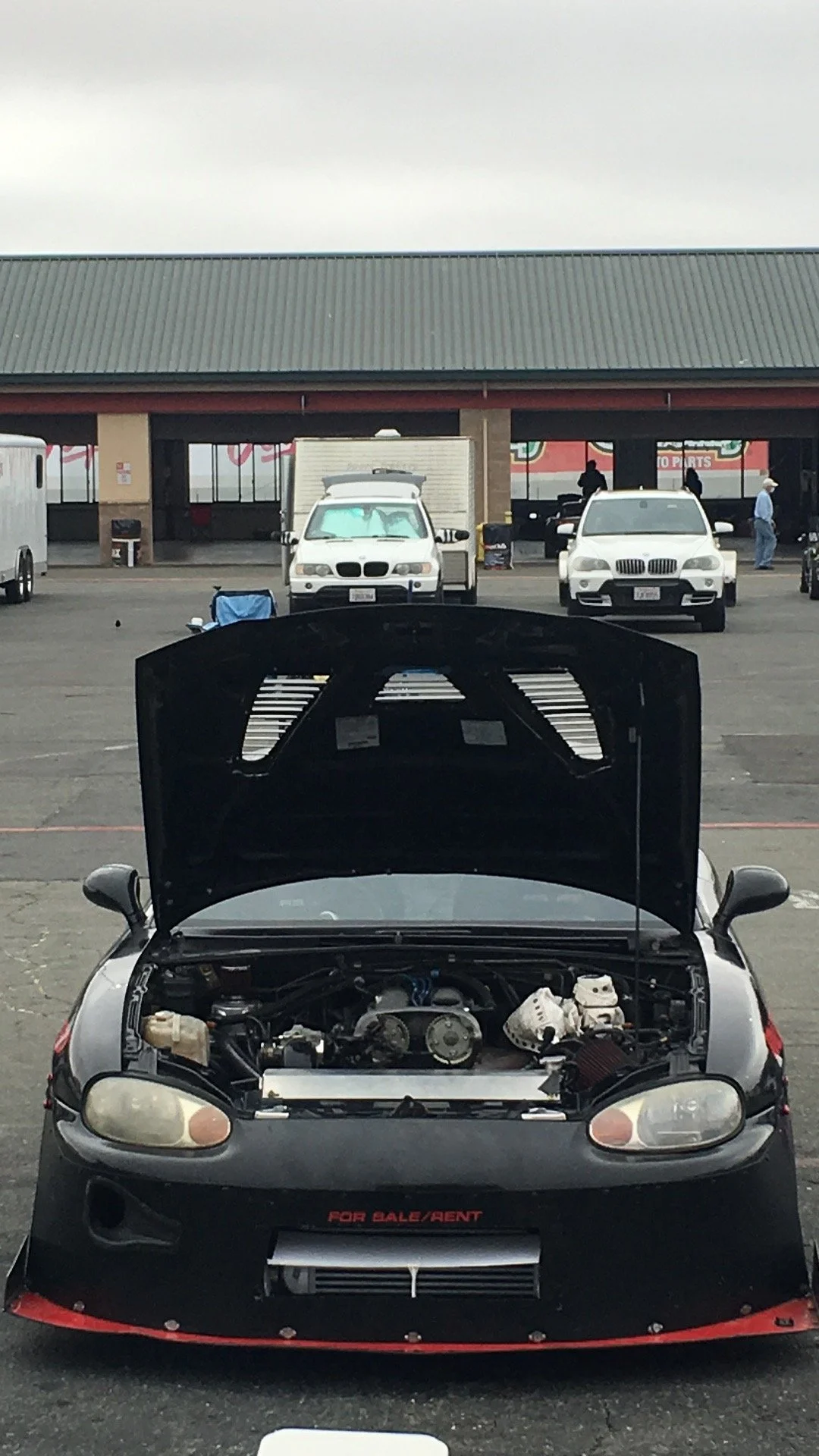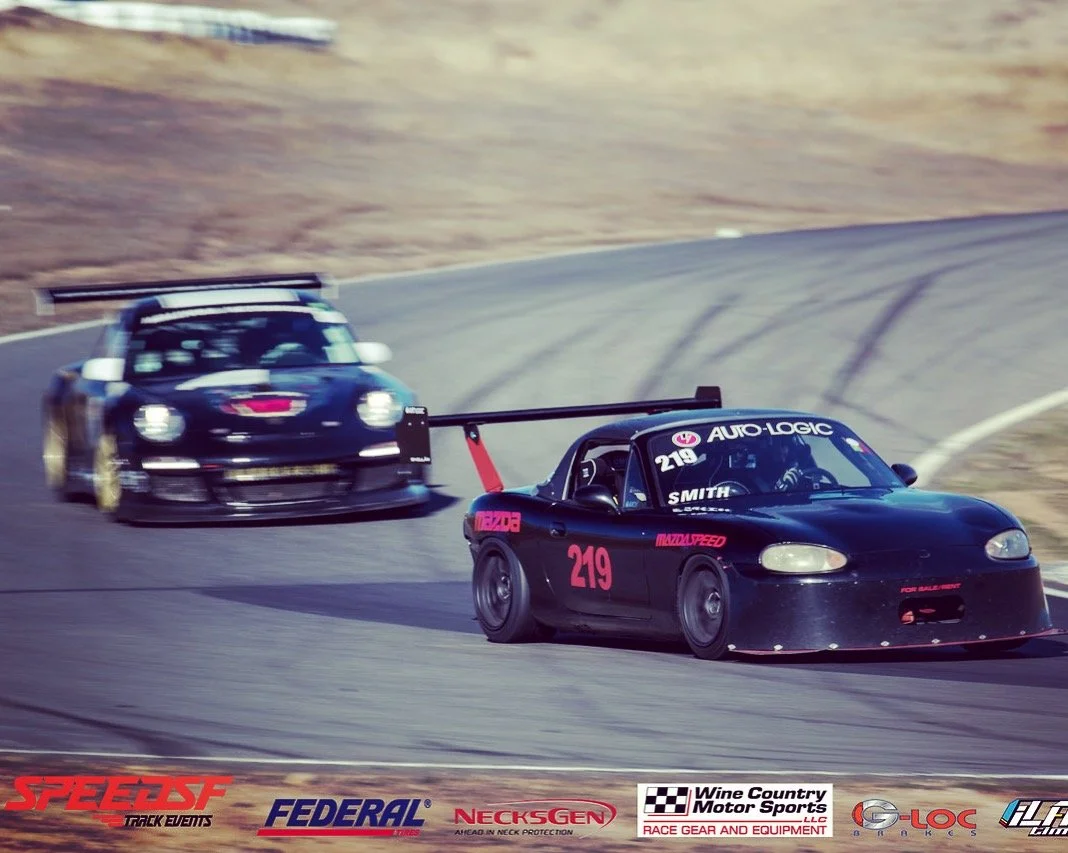Scott’s Turbo Miata: Slippery Slope
Halfway through a warm afternoon session at Buttonwillow, Scott Smith found it getting progressively tougher to get his Nismo 350Z into gear. He pulled in and quickly found the source of the problem: a failed clutch slave cylinder, a common issue with the Z33 HR platform. Soon, it was impossible to get the car into neutral, so he stalled it, called it a day, and limped it home to San Jose.
Before Scott left, SpeedSF’s Don gave him a chance to sample a svelte sports car — something to help lift his spirits a little. Don’s 1999 Mazda Miata was fairly basic, but with a built motor, sticky tires, a roll bar, and a racing seat, it provided the sort of thrill Scott was searching for. After a couple sessions in the refreshingly direct Miata, he started wondering what he was doing with the big Nissan. “If you decide to sell it, give me a call,” he urged Don.
One year later, Don made that call and Scott made the Miata his own — and began putting his mark on it by squeezing a little more out of the motor, which was already pretty peppy by 1.8-liter standards. Scott added a Skunk2 throttle body, a Mazdaspeed Miata exhaust cam, and the JDM flat top manifold for a total of 163 wheel horsepower and 140 lb-ft of torque.
It didn’t need much more for fun laps at half the Z’s cost, but Scott decided to splurge and lay the foundation for a grand build. The top-shelf Xidas, housed in 500 and 900-pound springs front and rear, respectively, may have been a bit much for such a basic car, but they did futureproof the build. He didn’t know it at the time, but he was just beginning a long tumble down a slick hillside towards excess.
To capitalize on the bump in power, Scott installed a Mazdaspeed six-speed gearbox and an OS Giken 1.5-way differential with a 4.77 final drive. While Joe Chang was building the diff, Scott asked him to build a custom splitter and air dam to glue the front to the track. For some time, this and a rear gurney flap was enough to keep him contented, but eventually the allure of a big wing thing caught his attention and he bolted on an APR GTC 300 at the rear. Though the spring rates were borderline overkill prior to adding the aero, they made it so he didn’t have to alter the suspension to support the moderate downforce produced by the the new elements.
In Scott’s mind, the Miata was then about as fun as anything in that price range. For something that could lap Laguna in the 1:42s, it was reasonably practical, too — practical enough to drive to the track and back in relative comfort. Since his main aim was getting the most out of the basic package he’d put together, he didn’t feel the need to touch the car for some time. Instead, he focused instead on maximizing seat time, and the approach paid off quickly; he soon broke the two-minute-barrier at Buttonwillow 13CW with a 1:58 and set a SpeedSF Challenge S5 record in the process.
That no-stress, no-mess lifestyle was addictive, but, whether he wished it or not, it had to come to an end. Most people start seeking big upgrades to again experience the spark that drew them to the car in the first place. In Scott’s case, a major modification was almost forced on him after a connecting rod punctured the block and started a short but violent oil fire. That day, several onlookers witnessed a Miata-sized fireball rolling down Sonoma’s drag strip. Thankfully, George Kibilov, then driving the car, was prudent enough to wear his fire suit and emerged unscathed. The car did not fare as well.
Thankfully, aside from the perforated motor, the damage was largely cosmetic. The rear bumper was scorched as well as the underside, but not beyond repair. Scott took the opportunity to go two feet in and make what was once a mild street car into a single-purpose track toy.
The second stage started with a return to Joe Chang for a custom motor. Joe directed the build and, since Scott was planning to turbocharge the motor, he suggested 9:1 compression, Wiseco pistons, Supertech valvetrain, ACL bearings and bolts, and a “secret Joe Chang spec” head.
Before Scott decided on the right whistler, Joe directed him to Jei Chang at Blacktrax for tuning. Jei advocated for the Adaptronic ECU and a GM ethanol reader so that the engine was both reliable and adaptable enough to accept different blends.
The turbo kit came courtesy of Ed May of 949 Racing. Ed had already run the kit on his own track car, but decided he’d be better off without a blower after deciding to return to autocross. The kit consists of an Absurdflow log manifold, a Garrett GT2871R turbo, a 3” exhaust, an upgraded Walbro 255 fuel pump, 1000cc ethanol-compatible injectors, a custom oil cooler and pan baffle, and an upgraded oil pump.
On a conservative twelve pounds of boost, the motor makes 254 horsepower and 208 lb-ft of torque at the tires. Added power was only part of the appeal — the kit was completely troubleshot, and the GT2871R promised near-instant response.
Jei’s tuning helped shape a flat, broad and usable torque curve — so usable that Scott can use fourth gear exiting corners which once required he use second. Jei programmed the AIM MXL dash to warn Scott of unsafe conditions. The AIM also reports the ethanol rating and self-adjusts the boost based on said value.
The added torque doesn’t change the driving experience much, but Scott did beef up the brakes and tires after boosting the motor. A set of Wilwood Dynapros up front and Maxxis RC1s on 10” 949 Racing wheels all around helped him brake for and accelerate out of corners in much the same way he would when his motor made half the grunt.
The turbo motor has been reasonably reliable in this guise, but there’s no getting around heat issues in the middle of summer. After three turns into a hot lap at Laguna Seca, the AIM warned Scott of creeping oil and coolant temps. The brakes had a habit of getting soft, as the turbo is just inches away from the brake fluid reservoir. Ducting and vented hood louvers proved valuable at the next event, keeping temps in check. As for the brake fluid, Scott wrapped the reservoir in an ‘aerospace thermal blanket’.
With the times kept falling rapidly, Scott began thinking a little masochistically. He figured that, since his car was well past the point of streetable, he figured he may as well take the next steps in his search for additional speed and scrap any hopes of keeping the car civlized.
Then Scott stripped the car and hired Tony Colicchio to install a full Spec Miata cage. Tony knew that weight was still a primary concern with this super Miata, and thus the cage was kept as simple as the weight, power, and outright speeds required; extra bars would only slow it down.
In its current configuration, the Miata weighs just 2,250 pounds. Being that svelte is a major factor when navigating slow, technical courses quickly; Scott can lap Thunderhill West in the 1:19s without too much effort. At faster tracks, the downforce plays a much larger role; it’s what allowed him to log his best-ever lap at Laguna last weekend: a 1:36.4. Scott notes that he ran multiple 1:36s throughout the day, while still “short-shifting and babysitting the gauges” and that “this car is my Spec Miata on steroids. It’s ten seconds faster at Laguna and Sonoma, but still dances like the Spec car; it just has to be driven harder given all the extra grip!”
The car currently runs on RC1s, but with points to grow in S3, he’s decided to find more grip — both mechanical and aerodynamic. A set of 245-section Hoosiers and a revised front splitter might help him shave another few seconds off his personal bests, and if all goes to plan, he might be able to shake things up at the front of the S3 grid to keep Legend (Toyota Supra), Joe (Lexus IS-F), and Patrick (E46 M3) on their toes.
For all the additional speed, Scott has paid a price. Not just the dollar value of all the goodies, but the ‘fun’ of lugging along his Spec Miata trailer, having to monitor the gauges on sweltering days, and bringing thirty gallons of E85 each outing.
Like so many in this position, he’s found a streetable compromise very appealing in the last couple years. After trying a few fast, heavy, and focused street cars, he settled on a PDK-equipped 987.2 Cayman S and threw the most basic of footwork mods at it.
This mildly fettled street car will lap Laguna Seca in 1:38s all day and carry Scott home from the track in total comfort. Plus, with the speeds it’s capable of, Scott has plenty of potential sparring partners; he can annoy any number of M3s if he wants to. It represents the inevitable compromise that every former purist arrives at eventually.
Simply put: it just works. No muss, no fuss, no ramps, no numb legs from sitting too long in a cramped bucket seat. It’s almost relaxing compared to the little firebreather. It’s only a couple seconds off the Miata at most tracks, too.
However, lap times only tell so much about the experience at speed. The Cayman may be competent and seriously quick, but the Miata is a pure, unadulterated thing that leaves Scott smiling for the rest of the afternoon. Is that extra oomph worth the headache? Well, it depends on the week Scott’s had. Some Saturday mornings call for a triple espresso injected directly into the carotid, and others are best with a comforting cup of chamomile.






